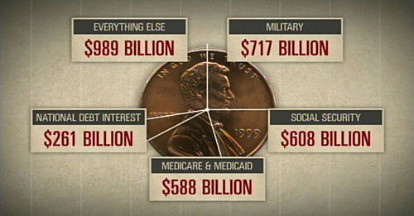Last night I watched IOUSA on the BBC iPlayer (unfortunately this was over cable TV – I can’t find it on the web iPlayer). It’s a film made by the former US Comptroller General, David Walker, which attempts to convince the viewer of the seriousness of America’s national debt problem.
…and it worked on me. The most effective aspect of the film was its use of infographics to convey a sense of historical scale. At its core was a recurring animated graphic showing the national debt from America’s inception through to the end of the George W Bush era in 2008.

Early on in the film you see the rises in the national debt from $0 in 1835 (the only point in history when it hit zero) up until the start of World War One. After that the graphic has to keep zooming out to fit in the subsequent growth. The Great Depression sees a quite unnerving hike – but as the World War Two period looms into view, it looks like a sheer cliff face. This is a shot of the graphic running up until 1988:

In the Clinton era the debt comes down, but then Bush takes charge in 2000 and things go through the roof, rocketing past WW2’s peak. The final sequence involving this graphic displays a projection for debt growth through to 2040. Baby boomers are set to retire en masse shortly and the effect on Social Security and Medicare spending will not be good. The effect this has on the infographic – the drastic zoom needed to chart the debt up to 2040 – almost gave me a sense of vertigo. It paints a pretty dystopian vision of the future.

Even though the film is unlikely to contain any new information for someone with more than an advanced lay knowledge of the current economic situation, I’d strongly recommend watching it. As well as the extremely well designed and animated graphics, it does a remarkably effective job of communicating the seriousness of the situation even to viewers who are already aware of most of the facts.
